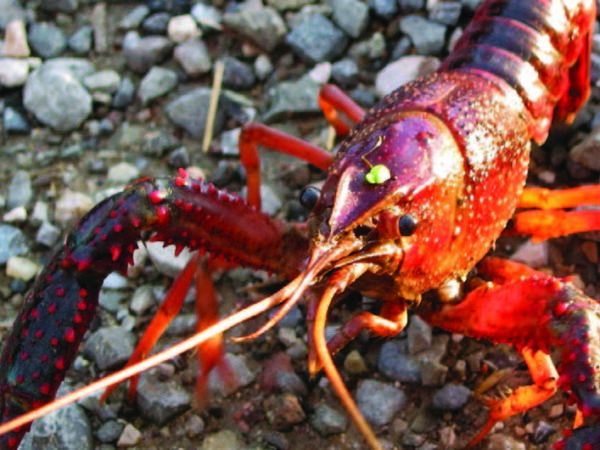
Red Swamp Crayfish
(Procambarus clarkii)
Species at a Glance
The Red Swamp Crayfish, also known as the Louisiana Crawfish or Mudbug, is a large and aggressive crayfish that can quickly dominate lakes, ponds, rivers, and wetlands. Often used in classrooms and as a popular food item, this highly adaptable crayfish has invaded the Great Lakes and beyond, impacting aquatic ecosystems by chewing up vegetation, outcompeting native species, and altering water quality.
Species Description
Adult Red Swamp Crayfish are known for their distinctive dark red, “boiled lobster” coloration with raised bright red, white, or black tubercles covering the body and claws. Occasionally, a genetic mutation may turn the body and/or claws blue. In some specimens, a black wedge-shaped stripe runs along the top of the abdomen. Juveniles are a uniform gray, sometimes overlain with dark wavy lines. A distinctive characteristic of this species is the nearly invisible areola, which is the narrow space between the plates of the carapace. The claws are narrow and long, and the rostrum has lateral spines or notches near its tip. Size is typically 5-12 cm (2-5 in).
Native and Introduced Ranges
The native range of the Red Swamp Crayfish extends from northern Mexico to the Gulf Coast and the Mississippi River drainage north to Illinois and Ohio. It has spread widely throughout the United States, with non-native reports of this species from at least 34 states. The Red Swamp Crayfish is not native to Pennsylvania; however, introduced specimens have been collected in the southeastern part of the state.
Habitat
The Red Swamp Crayfish prefers marshes, swamps, ponds, and slow-moving rivers and streams where there is plenty of organic debris like logs, sticks, or water-soaked leaves; however, it is tolerant of a wide range of habitats, including low oxygen levels, extreme temperatures, pollution, slightly brackish waters, and areas with large water level fluctuations. In times of drought or cold, the Red Swamp Crayfish can burrow into the sediment creating burrows with openings called or mud “chimneys”, until conditions are more favorable.
Biology & Spread
The Red Swamp Crayfish is a fast-growing, highly adaptable species with high reproductive potential, making it a popular aquaculture organism. It is commonly used in the food and aquarium trades, as live study specimens in classrooms, and as bait by anglers. Spread can occur through both intentional and accidental release. While it usually spreads via connected waterways, this species can crawl out of the water and travel several miles at night and during wet weather. In Pennsylvania, the Red Swamp Crayfish was commonly stocked in farm ponds until 2015, when new state crayfish regulations were passed by the Pennsylvania Fish and Boat Commission prohibiting their use.
Impacts
Threat to Biodiversity
Due to predation and competition, studies of the Red Swamp Crayfish have identified it as a major threat to native crayfish communities, other macroinvertebrates such as gastropods and insect larvae, and to amphibian populations. It is also a major risk to aquatic plant communities as it selectively forages and reduces plant cover. Furthermore, its impact on plant communities and its burrowing behavior can degrade ecosystems by increasing turbidity and sediment loads.
Economic Costs
Red swamp crayfish may have significant economic impacts on sport fisheries through predation on forage fish and juvenile sport fish. This species also can cause significant costs in agricultural damage and water management structures, as its burrowing behavior can be problematic to levees, dams, and irrigation systems.
Prevention & Control
The best way to prevent further ecological problems caused by the red swamp crayfish is to prevent or slow their spread into new waters. Never release live bait into any water body and never transport any crayfish from one water body to another. In Pennsylvania it is illegal to possess, import, or transport any crayfish species unless they are used as bait in the water they were taken from, or unless the head is immediately removed above the eyes before transport.
Resources:
- Lieb, D.A., Bouchard, R. W., & Carline, R.F. (2011) Crayfish Fauna of Southeastern Pennsylvania: Distributions, Ecology, and Changes Over the Last Century. Journal of Crustacean Biology, 31 (1), 166-178.
- Mid-Atlantic Panel on Aquatic Invasive Species. The Mid-Atlantic AIS Field Guide to Aquatic Invasive Species (2016). Field Guide
- Pennsylvania Fish and Boat Commission (2022) Aquatic Invasive Species Control Plan: Red Swamp Crayfish and White River Crayfish.



